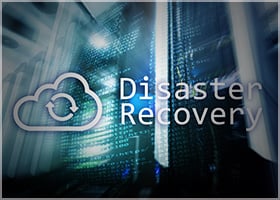 A disaster recovery (DR) plan is a living business document that contains step-by-step directions detailing how to restore your IT infrastructure and get back to work after a disaster. The goal of a disaster recovery plan is to make sure you are ready to respond when your business is interrupted by an event, such as a fire, storm, or cyberattack.
A disaster recovery (DR) plan is a living business document that contains step-by-step directions detailing how to restore your IT infrastructure and get back to work after a disaster. The goal of a disaster recovery plan is to make sure you are ready to respond when your business is interrupted by an event, such as a fire, storm, or cyberattack.
Every business should have a disaster recovery plan and a business continuity plan. When your business is interrupted by anything — a regional outage, weather event, cyberattack, or fire — you’ll have a plan in place that gives you step-by-step instructions for restoring your data and applications.
Business continuity (BC) is a documented strategy for minimizing downtime when there has been a service disruption.
The Difference Between DR and BC
Although DR and BC are related concepts and should be developed together, there are key differences between the two:
- Disaster recovery deals with restoring data and applications.
- Business continuity focuses on how to restore business operations after a service outage.
How to Develop a Disaster Recovery Plan
A good disaster recovery plan strikes the right balance between solution cost and recovery objectives. One easy way to understand this balancing act is to consider your organization’s tolerance for downtime. The more downtime you can tolerate, the less your DR solution will cost.
Key Components of a DR Plan
 Given the complexity of most modern businesses, the task of ensuring a comprehensive plan can seem daunting. There are established processes and guidelines for DR plan development that will help ensure that your plan considers all aspects.
Given the complexity of most modern businesses, the task of ensuring a comprehensive plan can seem daunting. There are established processes and guidelines for DR plan development that will help ensure that your plan considers all aspects.
Here is a brief overview of the key elements of a DR plan.
Business Impact Analysis
This is the planning stage where you set recovery time and recovery point objectives and priorities. With an objective set, you can create a framework for your plan.
It helps to outline different disaster scenarios and consider how they would impact business operations. These impact scenarios can help you identify which areas of your business are most critical so you can prioritize what services to restore first.
- Recovery Time Objective (RTO): How much time it will take to set up new infrastructure and resume operations. Can be seconds, minutes, hours, or days and weeks, depending on your goals and tolerance for downtime.
- Recovery Point Objective (RPO): How much data you can afford to lose: e.g., 1 minute, 30 minutes, one day.
Communication and Role Assignment
When disaster strikes, communication is essential for recovery. Keeping everyone on the same page through a disaster is crucial. A communication plan will ensure that everyone understands how to proceed.
Employees should understand their exact roles following a disaster. Disaster recovery documents should list current contact information for employees and vendors.
Recovery Instructions
Another essential component to establishing a disaster recovery plan is the creation of step-by-step recovery instructions. These instructions should include service restoration priorities. For example, the most critical applications should be identified as high priority for restoration.
Employees should have specific assignments, such as damage assessment, redirecting phone systems, and setting up workstations.
Document all aspects of your infrastructure. This will give the recovery team a template to follow.
Schematics to include:
- Network and data storage diagrams
- App dependencies
- Backup locations
- Restoration sequences
Disaster Recovery Lifecycle
A disaster recovery plan is a living document with a lifecycle of five phases:
- Impact and risk analysis: Study business risk and impact of various disaster scenarios. Develop a strategy to mitigate the most serious risks.
- DR solution design: Develop a DR plan that balances risk mitigation with solution cost.
- Implement: Create disaster recovery infrastructure and implement DR plan.
- Test: Test DR plan at regular intervals. Assess test results and implement modifications as required.
- Maintain: Keep documentation up to date with current contact information, best practices, and infrastructure schematics. Monitor DR infrastructure. Replace and update hardware and software as needed.
This list is by no means exhaustive, but it is a good foundation for the development of a truly comprehensive plan.
Businesses are unique. Therefore, your specific DR plan will require extensive customization. A disaster recovery service provider can help you assess your business risk and design the right DR solution.
Learn more about our disaster recovery and business continuity planning services.




Comment Form